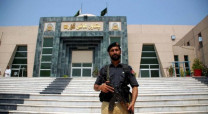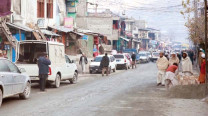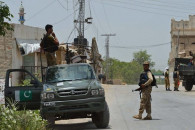Rains bring respite from scorching heat in K-P
Trigger flooding in local streams, nullahs

A new spell of rainfall across various districts of Khyber-Pakhtunkhwa on Tuesday brought relief from scorching heat but also caused flooding in streams and nullahs.
In Upper Dir, Chitral, Swat, and other adjoining upper areas, the downpour turned weather pleasant and broke the intensity of heatwave, putting smiles back on weary faces.
However, heavy rain in Upper Dir triggered flooding in local streams, leaving residents worried once again. Chitral and Swat also witnessed heavy rainfall.
In Chitral, flooding occurred in several areas overnight, forcing authorities to close the Ashret section of the Chitral road to traffic.
Several other roads were also blocked due to flash floods. Meanwhile, the local administration has advised citizens to avoid unnecessary travel.
In Haripur district, monsoon rains continued late into the night across all three tehsils. The heavy downpour disrupted various link roads, while both water reservoirs in the district have reached capacity.
The inflow of water at Tarbela Dam has reached 158,000 cusecs, while the water level at Khanpur Dam has risen to 1,980 feet.
This year's monsoon rains have left a trail of destruction in the province.
The United Nations Office for the Coordination of Humanitarian Affairs has said that 3,233 acres of agricultural land were damaged during the ongoing floods in the province.
The 'Rapid Needs Assessment' report prepared by UN-OCHA says Buner recorded the largest losses of agricultural land with 1,157 acres affected, followed by Swat with 853 acres, Shangla with 559 acres, and Swabi with 330 acres.
Over 80 per cent of people reported crop losses which were significant in Battagram and Mansehra, while Lower Dir and Torghar reported smaller but notable losses, further threatening food security and livelihoods, the UN-OCHA report says.
People lost about 6,206 livestock across the affected areas of 10 districts. Buner reported the highest losses with 4,818 animals, followed by Swat with 618, Shangla with 295, Battagram with 219, and Swabi with 105. Smaller but significant losses were recorded in Bajaur, Mansehra, Torghar, and Upper Dir, while Lower Dir reported minimal impact.
Report says over 80pc of people reported crop losses; 6,206 livestock lost
The loss of livestock further weakened the livelihoods of rural households already facing crop damage and displacement.
Across most flood-affected areas, market access has remained relatively stable. Overall, 77 per cent of markets were reported as accessible, with full access in districts such as Bajaur, Battagram, Lower Dir, Tor Ghar, and Upper Dir.
Swat and Mansehra also reported high levels of access, showing that even in areas severely hit by floods, physical access to markets was somehow maintained. However, Buner had the lowest access at only 35 per cent, leaving people there with limited options for essential supplies.
Despite this physical access, food and non-food availability in markets remains a challenge across many districts.
The regular supply of essential commodities was disrupted in 55 per cent of the affected areas, with Swabi, Shangla, and Swat facing the most significant interruptions.
This means that while people in several districts can reach markets, goods they need are often either unavailable or supplied inconsistently, affecting food security and basic household needs.
























COMMENTS
Comments are moderated and generally will be posted if they are on-topic and not abusive.
For more information, please see our Comments FAQ